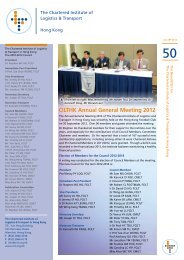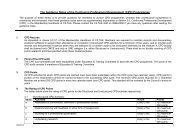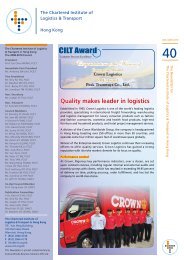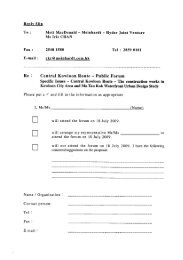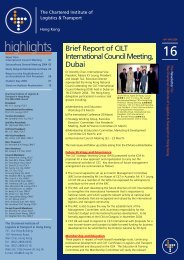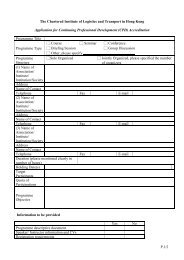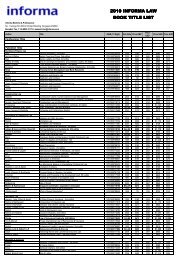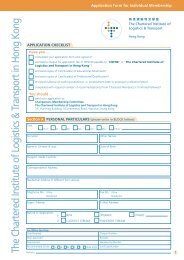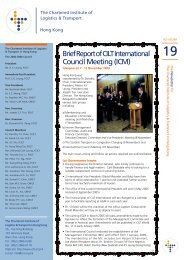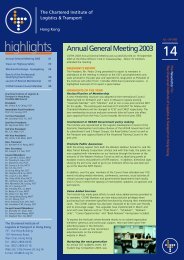PQE Sample Examination Questions - The Chartered Institute of ...
PQE Sample Examination Questions - The Chartered Institute of ...
PQE Sample Examination Questions - The Chartered Institute of ...
You also want an ePaper? Increase the reach of your titles
YUMPU automatically turns print PDFs into web optimized ePapers that Google loves.
<strong>The</strong> <strong>Chartered</strong> <strong>Institute</strong> <strong>of</strong> Logistics and Transport in Hong KongPr<strong>of</strong>essional Qualifying <strong>Examination</strong><strong>Sample</strong> <strong>Examination</strong> <strong>Questions</strong> and Suggested SolutionsCONTENTSOrdinary LevelOL1 Business Environment for Transport and Logistics 3OL2 Financial Management and Reporting for Transport and Logistics 4OL3 Marketing and Service Management 7OL4 Information Technology for Transport and Logistics 8Advanced LevelAL1 Law <strong>of</strong> Business and Carriage 9AL2 Management and Decision Making 10Transport Management StreamAL3 Transport Systems and Management 11AL4 Sustainable Transportation 12AL5 Transport Policy and Planning 13Logistics Management StreamAL6 Global Supply Chain Management 14AL7 Logistics Management 16AL8 Warehousing and Materials Handling 18<strong>Sample</strong> <strong>Examination</strong> <strong>Questions</strong> and Suggested Solutions - P.2
<strong>The</strong> <strong>Chartered</strong> <strong>Institute</strong> <strong>of</strong> Logistics and Transport in Hong KongPr<strong>of</strong>essional Qualifying <strong>Examination</strong><strong>Sample</strong> <strong>Examination</strong> <strong>Questions</strong> and Suggested SolutionsOL1 Business Environment for Transport and Logistics (2005/Q1)QUESTIONPrivate sector highway projects tend to be carried out under „Build-Operate-Transfer‟ (BOT)schemes. It is widely believed that BOT minimizes the burden <strong>of</strong> taxpayers. However, risksharing between the government and a private company has to be clearly defined in a BOTproject. Please: (i) define BOT, and (ii) explain the potential risks that have to be sharedbetween the government and a private company in a BOT project. (25 marks)SUGGESTED SOLUTION(i) <strong>The</strong> government signs a contract known as a „concession agreement‟ with a privatecompany to build, operate, maintain and manage the highway, in exchange for which theyare allowed to collect tolls fixed at a rate mutually agreed upon in the concession agreementfor a period <strong>of</strong> time, after which time the highway will revert to public control. (5 marks)(ii) Any five (4 marks each): Toll revenue shortfall risk – Traffic forecasts are usually inaccurate. Government <strong>of</strong>ficialshave incentives to justify public projects by overestimating traffic levels. <strong>The</strong> contractedtoll rates could be forced to be lowered under public pressure during an economicdownturn. Changes in gas taxes or vehicle registration fees could affect traffic levels. Construction risk – construction may be delayed and costs will overrun. Normallyconstruction risk is borne by the concession company. Foreign exchange risk – the value <strong>of</strong> the concession may be greatly reduced by a suddendevaluation <strong>of</strong> a foreign currency if the highway concession is a foreign owner. <strong>The</strong>government may provide guarantees against exchange risk in some concessionagreements. Maintenance risk – there is a risk that the concession company does not properly maintainthe road at the end <strong>of</strong> the concession contract. Maintenance costs may also rise due toinflation. Sovereign risk – there is a risk that the government will not honor its commitments.Government could change gas taxes, vehicle registration fees and other policies thatcould adversely affect the pr<strong>of</strong>itability <strong>of</strong> the concession. Moral hazard – As the government needs the road, it has an incentive to bail out thecompany in the case <strong>of</strong> financial distress.<strong>Sample</strong> <strong>Examination</strong> <strong>Questions</strong> and Suggested Solutions - P.3
<strong>The</strong> <strong>Chartered</strong> <strong>Institute</strong> <strong>of</strong> Logistics and Transport in Hong KongPr<strong>of</strong>essional Qualifying <strong>Examination</strong><strong>Sample</strong> <strong>Examination</strong> <strong>Questions</strong> and Suggested SolutionsOL2 Financial Management and Reporting for Transport and Logistics (2005/Q2)QUESTIONFinancial ratio analysis provides us with a useful tool to assess the performance <strong>of</strong> a logisticscompany.Below is an extract <strong>of</strong> the financial statements <strong>of</strong> ABC Logistics Company for the yearsended 31 Dec 2003 and 31 Dec 2004.(All figures in million HK dollars)Pr<strong>of</strong>it and Loss Account for the year ended 31 st December2004 2003Revenues 5,000,000 5,000,000Less: Cost <strong>of</strong> goods sold (4,000,000) (4,500,000)Gross Pr<strong>of</strong>it 1,000,000 500,000Less: Interest expenses (100,000) (80,000)Other operating expenses (400,000) (370,000)Net Pr<strong>of</strong>it 500,000 50,000Balance Sheet as at 31 st December2004 2003Fixed Assets 600,000 180,000Current AssetsStock 500,000 600,000Trade Debtors 900,000 564,500Cash at bank 10,500 9,0001,410,500 1,173,500Current liabilitiesTrade Creditors 200,000 182,000Other accruals 30,000 10,000230,000 192,000Long term liabilities10% Debentures 1,000,000 800,000Total Net assets 771,500 361,500Represented by:Ordinary Share Capital 100,000 100,000Reserves 671,500 261,500Total shareholders‟ funds 771,500 361,500(a)(b)Using ratio analysis, comment on the performance <strong>of</strong> ABC Logistics company over thetwo-year period in terms <strong>of</strong> pr<strong>of</strong>itability, liquidity, working capital and long term solvency.(20 marks)What are the limitations <strong>of</strong> ratio analysis? (5 marks)<strong>Sample</strong> <strong>Examination</strong> <strong>Questions</strong> and Suggested Solutions - P.4
<strong>The</strong> <strong>Chartered</strong> <strong>Institute</strong> <strong>of</strong> Logistics and Transport in Hong KongPr<strong>of</strong>essional Qualifying <strong>Examination</strong><strong>Sample</strong> <strong>Examination</strong> <strong>Questions</strong> and Suggested SolutionsOL3 Marketing and Service Management (2005/Q2)QUESTIONMarketing planning involves deciding on marketing strategies that will help the company toachieve its overall strategic objectives.Briefly identify the major steps in the formulation <strong>of</strong> an effective marketing plan. (25 marks)SUGGESTED SOLUTION<strong>The</strong> steps and a brief description <strong>of</strong> a marketing plan include: Executive summary - presents a brief summary <strong>of</strong> the main goals and recommendations<strong>of</strong> the plan for management review, helping management to find the plan‟s major pointsquickly. (4 marks) Current business environment - describes the target market and the company‟s positionin it, including information about the market, product performance, competition, anddistribution. (3 marks) Threats and opportunity analysis - assesses major threats and opportunities that theproduct might face, helping management to anticipate important positive or negativedevelopments that might have an impact on the firm and its strategies. (3 marks) Objectives and issues - state the marketing objectives that the company would like toattain during the plan‟s terms, and discuss key issues that will affect their attainment. (3marks) Marketing strategy - outlines the broad marketing logic by which the business unit hopesto achieve its marketing objectives and the details <strong>of</strong> market segmentation, targeting andpositioning. (3 marks) Action programs - spells out how marketing strategies will be turned into specific actionprograms that answer the following questions: What will be done? When will it be done?Who is responsible for doing it? And how much will it cost? (3 marks) Budgets - detail a supporting marketing budget that is essentially a projected pr<strong>of</strong>it-andlossstatement. (3 marks) Controls - outlines the control measures that will be used to monitor progress and allowhigher management to review implementation results and spot products that are notmeeting their goals. (3 marks)<strong>Sample</strong> <strong>Examination</strong> <strong>Questions</strong> and Suggested Solutions - P.7
<strong>The</strong> <strong>Chartered</strong> <strong>Institute</strong> <strong>of</strong> Logistics and Transport in Hong KongPr<strong>of</strong>essional Qualifying <strong>Examination</strong><strong>Sample</strong> <strong>Examination</strong> <strong>Questions</strong> and Suggested SolutionsAL1 Law <strong>of</strong> Business and Carriage (logistics & transport streams) (2007/Q1)QUESTION(a) Contrast the differences between a condition and a warranty. (13 marks)(b) Illustrate the circumstances in which a Court would uphold a contractual obligation in theabsence <strong>of</strong> an express term in the underlying contract. (12 marks)SUGGESTED SOLUTION(a) Candidates are expected to explain why terms in a contract are divided into conditionand warranty. (2 marks) Candidates should discuss the consequences <strong>of</strong> a breach <strong>of</strong> acondition and a warranty. (5 marks) Candidates are also expected to demonstrate theirunderstanding as regards what an innominate term is (3 marks) and what the remedy iswhen there is a breach <strong>of</strong> such term (3 marks).(b) Candidates are expected to set out that when a contract is reduced into writing, thegeneral proposition is that the Court will not adduce extrinsic evidence to interpret theeffect <strong>of</strong> any terms. (3 marks) Candidates are then expected to set out that in whatcircumstances the Court will imply a term in the contract in the absence <strong>of</strong> expressprovisions. For instance, an obligation which is well-known as a custom in a particulartrade. (3 marks) Secondly, such term is necessary for the performance <strong>of</strong> the contractand in the absence <strong>of</strong> which, the contract could not have been properly performed orgenerally known as “business efficacy” rule. (3 marks) Thirdly, Candidates are expectedto discuss the scope <strong>of</strong> a number <strong>of</strong> legislation that imply a number <strong>of</strong> duties oncontracting parties including the Sale <strong>of</strong> Goods Act and also the Supply <strong>of</strong> Goods andServices Act (if the course is subject to Hong Kong law, Sale <strong>of</strong> Goods Ordinance andSupply <strong>of</strong> Goods and Services Ordinance accordingly). (3 marks)<strong>Sample</strong> <strong>Examination</strong> <strong>Questions</strong> and Suggested Solutions - P.9
<strong>The</strong> <strong>Chartered</strong> <strong>Institute</strong> <strong>of</strong> Logistics and Transport in Hong KongPr<strong>of</strong>essional Qualifying <strong>Examination</strong><strong>Sample</strong> <strong>Examination</strong> <strong>Questions</strong> and Suggested SolutionsAL2 Management and Decision Making (logistics & transport streams) (2007/Q1)QUESTIONDefine decision-making. Explain the ways in which decision-making effectiveness can beenhanced. (7 marks)Describe how rational perspectives influence managers <strong>of</strong> transport or logistics firms indecision-making and list the steps that guide rational decision making. (9 marks) Comparethis with behavioral aspects <strong>of</strong> decision- making. (9 marks)SUGGESTED SOLUTIONDecision-making is the act <strong>of</strong> choosing one alternative from among a set <strong>of</strong> alternatives. <strong>The</strong>decision-making process includes recognising and defining the nature <strong>of</strong> a decision situation,identifying alternatives, choosing the “best” alternative, and putting it into practice. To helpenhance decision making effectiveness, managers <strong>of</strong>ten use interacting, Delphi, or nominalgroups or teams. Group and team decision making in general has several advantages as wellas disadvantages relative to individual decision making. Managers can adopt a number <strong>of</strong>strategies to help groups and teams make better decisions.(7 marks)Describe how rational perspectives influence the way in which transport or logisticsmanagers (with examples) make decisions. Rational perspectives on decision making rest onthe classical model. This model assumes that managers have complete information and thatthey will behave rationally. <strong>The</strong> primary steps in rational decision-making are: (9 marks)1. Recognising and defining the situation,2. Identifying alternatives,3. Evaluating alternatives,4. Selecting the best alternative,5. Implementing the chosen alternative, and6. Following up and evaluating the effectiveness <strong>of</strong> the alternative after it is implemented.Behavioral aspects <strong>of</strong> decision-making rely on the administrative model. This modelrecognizes that managers will have incomplete information and that they will not alwaysbehave rationally. <strong>The</strong> administrative model also recognizes the concepts <strong>of</strong> boundedrationality and satisfying. Political activities by coalitions, managerial intuition, and thetendency to become increasingly committed to a chosen course <strong>of</strong> action are all important.Risk propensity is also an important behavioral perspective on decision making. Finally,ethics also affect how managers make decisions. (9 marks)<strong>Sample</strong> <strong>Examination</strong> <strong>Questions</strong> and Suggested Solutions - P.10
<strong>The</strong> <strong>Chartered</strong> <strong>Institute</strong> <strong>of</strong> Logistics and Transport in Hong KongPr<strong>of</strong>essional Qualifying <strong>Examination</strong><strong>Sample</strong> <strong>Examination</strong> <strong>Questions</strong> and Suggested SolutionsAL3 Transport Systems and Management (transport stream) (2003/Q2)QUESTIONDiscuss the objectives <strong>of</strong> public transport priority measures for the traffic management.Suggest criteria for evaluating the use <strong>of</strong> bus-only lanes. (25 marks)SUGGESTED SOLUTION• Objectives for public transport priority measures (12 marks)‣ To improve the conditions and reliability <strong>of</strong> bus operators through the introduction<strong>of</strong> appropriate bus priority measures;‣ To alter the traffic balance in favor <strong>of</strong> buses at those locations where this can beproperly justified;‣ To improve conditions for bus passengers at stops and interchanges‣ To improve road safety in particular for pedestrians, cyclists and people withdisabilities;‣ To review hours <strong>of</strong> operation <strong>of</strong> waiting and loading restrictions;‣ To establish and implement the coordinated and coherent application <strong>of</strong> waiting,parking and loading enforcement regimes on bus route corridors‣ To improve conditions for all road users and frontages on bus route corridors• Evaluation <strong>of</strong> bus priory measure: (13 marks)‣ Bus and other vehicle occupancies‣ Bus journey time‣ Bus headways‣ Junction queue lengths and delays‣ Classified traffic counts‣ Parking occupancy and duration‣ Junction designs and evaluation <strong>of</strong> time saving are based on the use <strong>of</strong> simulationprograms. This evaluation identifies benefits such as: time cost savings for buspassengers and crew; bus operation cost saving‣ Improved bus service regularity and reliability, due to less variation in travel time asthe variable delays due to congestion are avoided;‣ Generated bus patronage due to reduced travel time and improved mobility <strong>of</strong> buspassengers;‣ Time savings, enabling the bus operate to keep the same frequency <strong>of</strong> servingusing fewer vehicles or to improve the frequency <strong>of</strong> service with the same number<strong>of</strong> vehicles;‣ De-congestion where a shift to bus usage results in less car traffic and so reducedelays for all traffic.<strong>Sample</strong> <strong>Examination</strong> <strong>Questions</strong> and Suggested Solutions - P.11
<strong>The</strong> <strong>Chartered</strong> <strong>Institute</strong> <strong>of</strong> Logistics and Transport in Hong KongPr<strong>of</strong>essional Qualifying <strong>Examination</strong><strong>Sample</strong> <strong>Examination</strong> <strong>Questions</strong> and Suggested SolutionsAL4 Sustainable Transportation (transport stream) (2007/Q1)QUESTION(a) What are the functions <strong>of</strong> Environmental Impact Assessment (EIA)? (12 marks)(b) If the government decides to build a new mass transit railway connecting two districtswith reclamation projects, what are the possible environmental aspects that would beincluded in the EIA <strong>of</strong> such project? (13 marks)SUGGESTED SOLUTION(a) What is EIA (3 marks) <strong>The</strong> procedure for evaluating the potential environmental consequences <strong>of</strong> majorprojects. <strong>The</strong> EIA procedure seeks to prevent pollution problems, to minimizeenvironmental damage and to avoid expensive remedial measuresFunctions <strong>of</strong> EIA (9 marks, any 3 <strong>of</strong> below) EIA as a tool in the eco-political decision making process - for example, the PADS.This EIA involves a series <strong>of</strong> interlinked projects called the Airport Core Program(ACP) projects. EIA as a comprehensive description <strong>of</strong> an environmentally important mishap, mistakeor malfunction . EIA as necessary step in the structure and shape <strong>of</strong> a proposed development. EIA as tool for sustainable development(b) Possible impacts (10 marks; any 10 aspects with elaborations) gaseous emissions dust odor noisy operation night time operations traffic generation liquid effluents, discharges, or contaminated run<strong>of</strong>f generation <strong>of</strong> waste or by-products storage, handling, transport or disposal <strong>of</strong> hazardous materials or wastes risk <strong>of</strong> accidents which would result in pollution or hazard disposal <strong>of</strong> spoil material, including potentially contaminated material soil contamination unsightly visual appearance other relevant aspectsOthers (3 marks) Organization Logical presentation Originality<strong>Sample</strong> <strong>Examination</strong> <strong>Questions</strong> and Suggested Solutions - P.12
<strong>The</strong> <strong>Chartered</strong> <strong>Institute</strong> <strong>of</strong> Logistics and Transport in Hong KongPr<strong>of</strong>essional Qualifying <strong>Examination</strong><strong>Sample</strong> <strong>Examination</strong> <strong>Questions</strong> and Suggested SolutionsAL5 Transport Policy and Planning (transport stream) (2003/Q2)QUESTIONPrioritize the following infrastructure development projects:a. A bridge connecting Hong Kong, Zhuhai and Macau.b. <strong>The</strong> fourth cross-border crossing connecting Hong Kong and Shenzhen.c. A freight rail connecting Shenzhen, Guangzhou and the Central China.d. A high-speed train connecting Hong Kong and Guangzhou.State and explain the criteria that you have used to rank the above projects. (25 marks)SUGGESTED SOLUTION• Students can make any ranking among the four, provided that the content <strong>of</strong> thearguments are consistent with the ranking. (12 marks)• Criteria for assessing the ranking (8 marks)‣ Economic returns – Social and economic benefits <strong>of</strong> the project, enhancement inregional development, increase the GDP <strong>of</strong> the regions.‣ Financial returns – whether it is pr<strong>of</strong>itable if it is a stand-alone project.‣ Budgetary constraint – need to consider private-public partnership or BOT‣ Environmental Impacts –‣ Operational/Engineering viability‣ Political acceptability‣ Social Impacts‣ Timing – construction and effective date; enough demand for the infrastructure,coordination with other developments.‣ Other criteria• Content/arguments are consistent with the criteria stated (2 marks)• Organization, logicality, originality, relevancy to Hong Kong (3 marks)<strong>Sample</strong> <strong>Examination</strong> <strong>Questions</strong> and Suggested Solutions - P.13
<strong>The</strong> <strong>Chartered</strong> <strong>Institute</strong> <strong>of</strong> Logistics and Transport in Hong KongPr<strong>of</strong>essional Qualifying <strong>Examination</strong><strong>Sample</strong> <strong>Examination</strong> <strong>Questions</strong> and Suggested SolutionsAL6 Global Supply Chain Management (logistics stream) (Jan 2003/Q2)QUESTION(a) One <strong>of</strong> the core elements <strong>of</strong> supply chain management is to have total visibility <strong>of</strong> carg<strong>of</strong>low in the pipeline so that quick response can be achieved. What are the commontechnologies used in providing full transparency <strong>of</strong> consignment status? (15 marks)(b) More and more advanced technologies are developed and available for commercial use.State the key factors that organizations have to consider before adopting these newtechnologies. (10 marks)SUGGESTED SOLUTION(a) Bar coding (2.5 marks)It represents the most commonly used automatic identification technology. Consideringthat there are numerous bar-code symbologies, or standards, in use today, consistency<strong>of</strong> technologies is essential for moving products effectively and efficiently through supplychains.Electronic data interchange (2.5 marks)It is the organization-to-organization, computer-to-computer exchange <strong>of</strong> business datain a structured, machine-processable format. <strong>The</strong> purpose <strong>of</strong> EDI is to eliminateduplicate data entry and to improve the speed and accuracy <strong>of</strong> information flow bylinking computer applications between companies.XML (2.5 marks)Short form for extensible markup language, XML is a method <strong>of</strong> packing information formovement on the Internet. This is a highly efficient way to package information, suchthat it can be readily accessible to any person or company having Internet or Webbasedcapabilities. <strong>The</strong> potential <strong>of</strong> XML is that over time it will prove to be a preferredsubstitute to the use <strong>of</strong> electronic data interchange.RF technology (2.5 marks)This is particularly useful in the warehouse or distribution center. RF allows users torelay information via electromagnetic energy waves from a terminal to a base station,which is linked in turn to a host computer. When combined with a bar-code inventorysystem for identifying inventory items, an RF system can update inventory records in“real time”. This results in significant improvement to the quality <strong>of</strong> order-picking andshipping accuracy.Satellite tracking (2.5 marks)Driver has access to computerized capabilities, such as global positioning that providesa real-time knowledge <strong>of</strong> the truck‟s current location and directions to intendeddestinations.Others (2.5 marks)<strong>Sample</strong> <strong>Examination</strong> <strong>Questions</strong> and Suggested Solutions - P.14
<strong>The</strong> <strong>Chartered</strong> <strong>Institute</strong> <strong>of</strong> Logistics and Transport in Hong KongPr<strong>of</strong>essional Qualifying <strong>Examination</strong><strong>Sample</strong> <strong>Examination</strong> <strong>Questions</strong> and Suggested SolutionsAL6 Global Supply Chain Management (logistics stream) (Jan 2003/Q2)(b) <strong>The</strong> following considerations are relevant to the process <strong>of</strong> adapting to new informationtechnologies:‣ It is important to have a scientific as well as an intuitive understanding <strong>of</strong> customerand supplier information requirements, as well as those <strong>of</strong> all supply chainparticipants. It is necessary for information technologies to be flexible andadaptable, depending on the specific set <strong>of</strong> needs being served. (1.5 marks)‣ It is necessary to recognize that implementation delays can result from a lack <strong>of</strong>coordination and integration among key logistics and supply chain processes.Inconsistencies and lengthy order cycles can result from the failure to synchronizelogistics operational versus coordination activities. (1.5 marks)‣ It is important to see that the logistics organizational strategies move from afunctional to a process orientation. (1.5 marks)‣ Inevitably, early implementation efforts may suffer due to poor data or the nonavailabilityor non-sharing <strong>of</strong> future data pertaining to future orders, forecasts andtarget production schedules. (1.5 marks)‣ It is important that the organization has the financial resources needed to assure asmooth, full implementation. A willingness among employees to accept and makeuse <strong>of</strong> new technologies is also critical to this process. It should formulate strategyto make employees more enthusiastic and less resistant to change. (1.5 marks)‣ It is necessary for firms to create opportunities for interaction and team effortsamong logistics managers and those others most knowledgeable about informationtechnologies. (1.5 marks)‣ Others (1 mark)<strong>Sample</strong> <strong>Examination</strong> <strong>Questions</strong> and Suggested Solutions - P.15
<strong>The</strong> <strong>Chartered</strong> <strong>Institute</strong> <strong>of</strong> Logistics and Transport in Hong KongPr<strong>of</strong>essional Qualifying <strong>Examination</strong><strong>Sample</strong> <strong>Examination</strong> <strong>Questions</strong> and Suggested SolutionsAL7 Logistics Management (logistics stream) (Jan 2003/Q1)QUESTION<strong>The</strong>re are various components in logistics management. However we would always consider“total logistics cost” when dealing with logistics problems. Explain the concept <strong>of</strong> “totallogistics cost”. (14 marks) Identify the three main components in the logistics process andexplain their importance. (9 marks) Do you agree that the concept <strong>of</strong> “total logistics cost” iscritical in determining logistics solutions? (2 marks)SUGGESTED SOLUTION<strong>The</strong> elaboration <strong>of</strong> at least seven components <strong>of</strong> the TLC in logistics management: (2 pointsfor each component and maximum <strong>of</strong> 14 points),<strong>The</strong> idea <strong>of</strong> the total logistics costs (TLC) is shown below:TLC = TC + WC + CC + IC + MC + PC + MAwhere TLC = total logistics costsTC = transportation costs (fleet and operational management)WC = warehouse costs (rent or mortgage)CC = communication costs (order processing and distribution channel)IC = inventory costs (holding and order cost <strong>of</strong> the stock)MC = material handling costs (equipment)PC = packaging costs (material and design fee)MA = management costs (value-added integrated process management)<strong>Sample</strong> <strong>Examination</strong> <strong>Questions</strong> and Suggested Solutions - P.16
<strong>The</strong> <strong>Chartered</strong> <strong>Institute</strong> <strong>of</strong> Logistics and Transport in Hong KongPr<strong>of</strong>essional Qualifying <strong>Examination</strong><strong>Sample</strong> <strong>Examination</strong> <strong>Questions</strong> and Suggested SolutionsAL7 Logistics Management (logistics stream) (Jan 2003/Q1)• <strong>The</strong> most important 3 components and the customer service level are 3 points eachanswer:TransportationWarehouse/DistributionLocationCustomerServiceLevelInventory Mgt‣ <strong>The</strong> inventory cost is about 60% <strong>of</strong> the total logistics costs so it is the most importantactivity to be looked after. <strong>The</strong> stock level affects the frequency <strong>of</strong> delivery and thesize <strong>of</strong> warehouse/number <strong>of</strong> warehouses.‣ <strong>The</strong> second important cost element is transportation which counts for 18% <strong>of</strong> thetotal logistics costs. <strong>The</strong> size <strong>of</strong> vehicle fleet, its routing and scheduling will affect thenumber <strong>of</strong> warehouse/distribution centres in the distribution network.Additional 2 points for students able to demonstrate the relationship between TLC andlogistics solutions‣ Warehousing is the third single cost element to be dealt with. <strong>The</strong> catchment <strong>of</strong> thewarehouse will affect the transportation need and inventory level.‣ Customer service level is not directly related to TLC but it determines the totalbudget <strong>of</strong> the logistics operation.[Students can provide different components with sufficient justification. However, itshould be the three components as discussed above]<strong>Sample</strong> <strong>Examination</strong> <strong>Questions</strong> and Suggested Solutions - P.17
<strong>The</strong> <strong>Chartered</strong> <strong>Institute</strong> <strong>of</strong> Logistics and Transport in Hong KongPr<strong>of</strong>essional Qualifying <strong>Examination</strong><strong>Sample</strong> <strong>Examination</strong> <strong>Questions</strong> and Suggested SolutionsAL8 Warehousing and Materials Handling (logistics stream) (2007/Q1)QUESTION(a) To maintain competitiveness, the amount <strong>of</strong> inventory <strong>of</strong> an organization needs to becontrolled, if not eliminated at all, in order to reduce inventory cost. With this objective,explain in detail the reasons for a need <strong>of</strong> keeping inventory. (5 marks)(b) List and describe the functions <strong>of</strong> a warehouse and the value added activities carriedout in a warehouse to justify its existence. (8 marks)(c)<strong>The</strong> use <strong>of</strong> mechanical handling equipment is almost indispensable in a modernwarehouse. Identify any four types <strong>of</strong> mechanical handling equipments commonly usedin warehouse operations and explain how these equipments enhance storage spaceutilization and operation efficiency. Illustrate your answer with the aid <strong>of</strong> diagramswhere necessary. (12 marks)SUGGESTED SOLUTION(a) 5 marks for explaining why inventory is still necessary hence the need <strong>of</strong> a warehouseTo achieve transportation economiesTo achieve production economiesTo take advantages <strong>of</strong> quantity purchase discounts and forward buysTo support the firm‟s customer service policiesTo meet changing market conditions (e.g. seasonality, demand fluctuations,competition)To overcome the time and space differentials that exist between producers andconsumersTo support just in time programs <strong>of</strong> suppliers and customers(b) 8 marks for giving correct details on the functions <strong>of</strong> warehouse, and the value-addedactivities they can handleFunctions Storage Product distribution Smoothing out logistics flow Increased customer satisfaction Logistics data collectValue-added activities Product mixing (pick and pack) Product consolidation Product distribution Product repackaging, labeling to support sales activities Handling <strong>of</strong> rejected goods<strong>Sample</strong> <strong>Examination</strong> <strong>Questions</strong> and Suggested Solutions - P.18
<strong>The</strong> <strong>Chartered</strong> <strong>Institute</strong> <strong>of</strong> Logistics and Transport in Hong KongPr<strong>of</strong>essional Qualifying <strong>Examination</strong><strong>Sample</strong> <strong>Examination</strong> <strong>Questions</strong> and Suggested SolutionsAL8 Warehousing and Materials Handling (logistics stream) (2007/Q1)(c)3 marks each for elaborating details (usage, specific nature, constrains, etc.) <strong>of</strong> any four<strong>of</strong> the following material handling equipment: Electric stacker Forklift truck Narrow aisle high rise truck Overhead crane Pallet Hoist Conveyor belt<strong>Sample</strong> <strong>Examination</strong> <strong>Questions</strong> and Suggested Solutions - P.19



